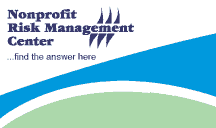| |
October 28, 2009
Halloween, Unmasking Risk and Your Nonprofit
By Melanie Lockwood Herman
You’ve probably heard it from others or perhaps have even uttered it yourself: Halloween isn’t the same as it was “back in the day.” When I was a child Halloween costumes began as grand concepts that morphed into wearable works of art over a period of days or weeks. And the evening itself was planned down to a “T.” We scoped out the route, estimated the number of houses we would visit, and selected a bag or sack guaranteed to hold up under the weight of our calorie-laden, cavity-causing loot. We had to arrive home from our evening of Trick or Treating at least an hour before bedtime to allow time to scrutinize the “take,” trade least favorite items with siblings, and consume as much as possible before suffering a stomach ache or Mum’s disapproval.
These days my Halloween preparations begin with a dreaded trip to the local “party” store where I will try to persuade my daughter to select a tasteful costume. She is predictably drawn to the costumes that she believes will make her look both scary and cool, while I’m drawn to the diminishing assortment of G-rated costumes—the big pumpkin, the friendly ghost and similar get-ups. I invariably wind up spending $50 for a poorly made outfit that will be worn and discarded faster than you can say “boo.”
Although I was unaware at the time, my childhood Halloween rituals involved more than gluttony. Upon reflection, I can now see that both science and risk management were involved. First, we always ventured out with my Dad as our trusty escort. True, even then it wasn’t cool to have a parent in tow, but he offered a steady arm to lean on when we encountered difficulty walking up steps or on uneven sidewalks in our often elaborate, hand-crafted cardboard costumes (I was a giant pumpkin and my sisters played the roles of Big Bird and a tree with real branches attached). Second, we always engaged in contingency planning. After visiting several adjacent homes offering less than acceptable “loot” (e.g., the dreaded apple) or encountering a section of unlit homes hostile to young, costumed beggars, we changed course and headed off down the pre-selected, alternate route.
Many nonprofit leaders bemoan the lack of data available to “predict” the future. An organization’s leaders may describe their greatest fear as exposure to “low frequency/high severity” losses and argue that forecasting such losses is akin to predicting the exact location of a lightning strike. Yet even without databases containing detailed loss data, every nonprofit leader can endeavor to sort through the uncertainty facing their organizations and adjust measures of probability based on new data and experience. Nonprofit executives need to identify potential helpful sources of information and insight and scan these data sources in order to adjust their assumptions and predictions about the future. While some of the data may not be welcome (e.g., declining product sales or lower average donation), all of it is potentially useful in evaluating and managing risk. For example:
- The complaint from a disgruntled volunteer. Instead of “writing off” the volunteer as “high maintenance,” consider probing for the reasons behind the volunteer’s negative view. Commit to turning the lessons from this volunteer’s experience into learning for the nonprofit that will increase the odds of future success.
- Declining membership revenues or donations. Rather than speculate about the reasons for the decline and attribute these and similar poor results to “poor economic conditions,” contact those who don’t renew their support and ask “why?” The results may be surprising and helpful as you plan next year’s campaign.
- News from area funders that funding priorities and patterns are changing. Without further inquiry it is impossible to predict with accuracy whether such changes will affect the nonprofit’s pending application for funding. Speculative feelings of invincibility (“they couldn’t possibly cut us off!”) or jeopardy (“we’re doomed”) are unlikely to be helpful in the short or long-term.
The process of undertaking a risk assessment involves considering a nonprofit’s circumstances, priorities, goals, exposures, risk-taking appetite and the organization’s current strategies (and capabilities) for managing risk. Many leaders see this as a short-term exercise that is scheduled every few years. Effective nonprofit leaders should commit to going through the process, but also the ongoing “instrument scan” that is necessary to protect their vital missions. Remember that even without the benefit of a claims database or crystal ball, every nonprofit has data sources from which it can glean information and insights to adjust its predictions about the future and calibrate its policies and action steps accordingly.
Risk Management Resources Available from the Center
The Nonprofit Risk Management Center offers a range of resources for nonprofit leaders working to manage uncertainty. As part of our consulting practice the Center offers “risk assessments” that involve the review of exposures, stakeholder perspectives, and existing policies and operational practices. A risk assessment typically concludes with the delivery of a detailed report and briefing on the top risks facing the organization and the Center’s assessment of the adequacy of current risk management measures. The capstone of these assignments is a list of specific but practical recommendations for managing current and emerging risks. To inquire about this service.
Another risk management resource is the just-released book Ready…or Not: A Risk Management Guide for Nonprofit Executives.
Ready…or Not takes a fresh look at core topics in the discipline of risk management, including risk communication, managing stakeholder expectations, and special topics such as business continuity planning and crisis management. Additional information on the book is available at: http://nonprofitrisk.org/store/ready_or_not.shtml.
For leaders seeking help designing practical policies the Center offers My Risk Management Policies, an easy-to-use, affordable online tool that will help you craft custom policies for your nonprofit, including a conflict of interest and other important governance policies. For more information on this brand-new tool, visit: http://nonprofitrisk.org/tools/mrmp/mrmp.shtml. To purchase the tool, visit www.MyRiskManagementPolicies.org. The one-time cost of
My Risk Management Policies is $179.
In addition to our consulting services, publications and online tools, the Center is frequently asked to design and deliver presentations on various risk management topics. The cost of a custom workshop or keynote is $2,500 plus actual travel expenses. Custom 60 or 90-minute webinars are available for $1,800. In both instances the Center produces a detailed handout for attendees. To inquire about the availability of either Melanie Lockwood Herman (executive director) or Carlye Christianson (senior counsel and director of special projects), call (202) 785-3891. To view a list of upcoming engagements, visit: http://nonprofitrisk.org/calendar/speaking.shtml.
Fall Issue of Risk Management Essentials Now Available
The Fall issue of the Center’s newsletter, Risk Management Essentials, is now available. To download a PDF of the newsletter, click here. To view the articles featured in the new issue online, click here. To request copies of the printed version for distribution within your organization, contact Sue Weir Jones at (202) 785-3891 or Sue@nonprofitrisk.org.
|


